Jersey Geology Trail |
Rhyolite. (Gk. rhuax=lava stream; lithos=stone). |
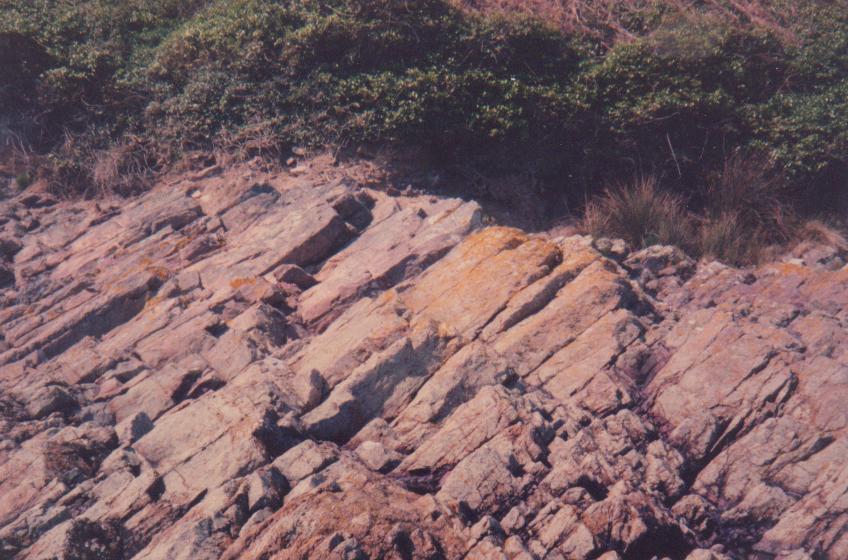 |
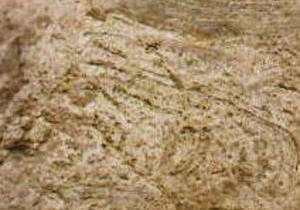 |
Columnar and flow-banded rhyolites, La Crête Point & Le Havre de Fer. |
| |
 |
Flow banded rhyolite with secondary iron often showing a boundary of possible arrested alteration. |
| |
Rhyolite is generally a light coloured, finely crystalline extrusive acid igneous rock composed of quartz, orthoclase feldspar and biotite some with minor pyroxene and amphibole. Peralkaline or NaK rich rhyolites are found as end members of alkaline magma series on oceanic islands and rifted continental crust (Allaby & Allaby, 1990, p. 464. The slow - flowing viscous lava produces more dome-shaped than cone-shaped volcanoes.
In Jersey, rhyolites form the second major volcanic rock type and have been divided into the St. John's Rhyolite Formation (porphyritic) and the Bouley Rhyolite Formation (aphyric-finely crystalline, ie. no phenocrysts) (Bishop & Bisson, 1989. p. 13) and are c. 950m and c. 430m thick respectively but unfortunately no vents, craters or obvious feeders have been found in either the andesites or the rhyolites of the Jersey Volcanic Group.
These formations, which probably should be called ignimbrites after the main rock types within them, crop out on the north and east coasts with arcuate subcrops between the two coasts, forming a syncline plunging gently to the north east. They consist of five different flows, the lowest of which lies with angular unconformity on the St. Saviour's Andesite Formation. All display eutaxitic and fiamme textures produced by flattened and streaked shards of glass and pumice respectively. The ignimbrites have been described again in this section to give a more complete idea of the succession.
The St. John's Rhyolite Formation.
On the north coast, the St. John's Rhyolite consists of the Bonne Nuit Ignimbrite overlain by the Frémont Ignimbrite between Le Côtil Point and Frémont Point. Within these two units there are xenoliths of the country rocks, shale (of the Jersey Shale Formation) and andesite (of the St. Saviour's Andesite Formation), and sedimentary units of mudstones and conglomerates as well as erosional horizons.
In the Bonne Nuit Ignimbrite, isolated exposures of attenuated concentrations of quartz, and of possible pink spherulites or detached fragments showing no internal structure, in a light grey groundmass, occur on the eastern side of a mid-bay outcrop. |
| |
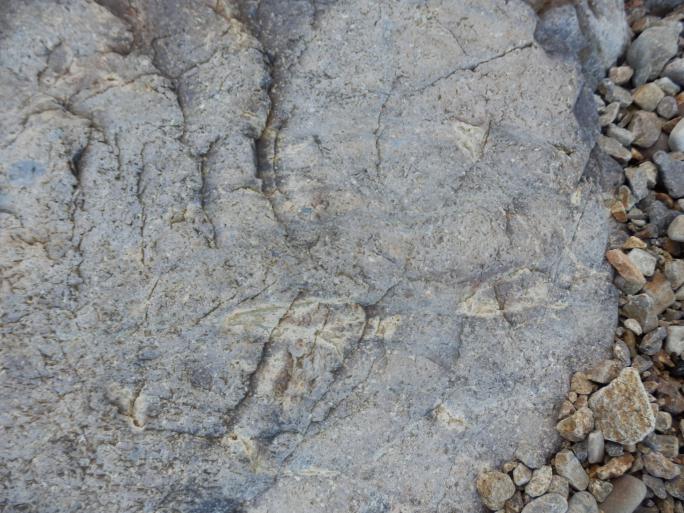 |
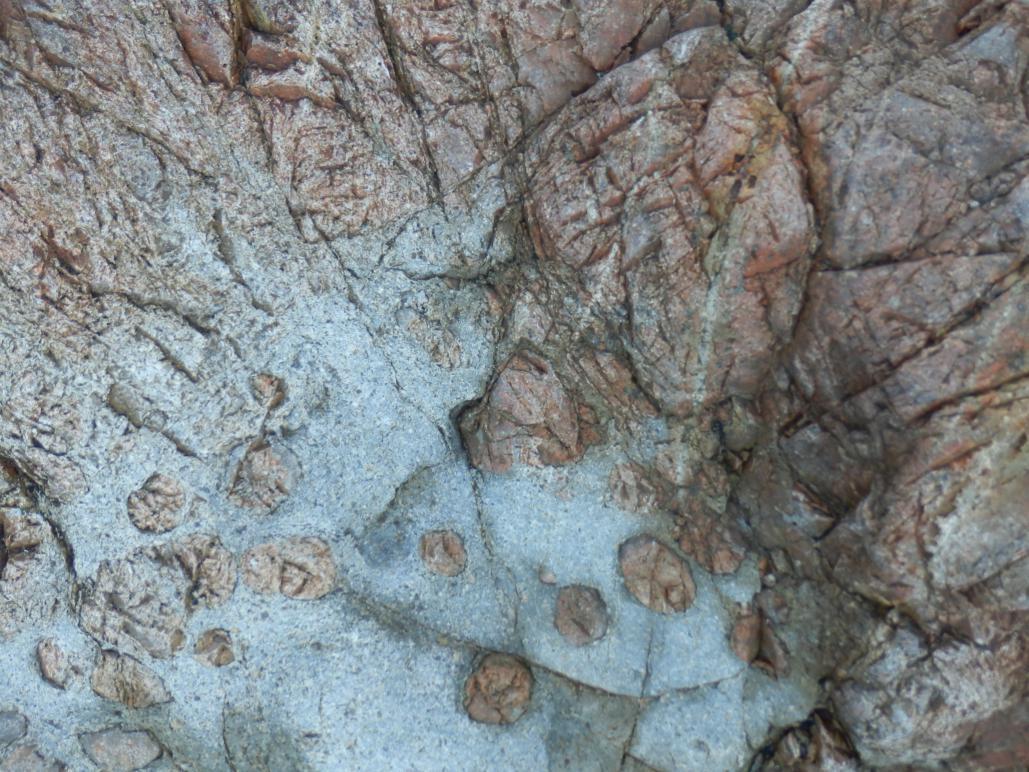 |
Ignimbrite attenuated structures. |
Possible spherulites or detached fragments. |
| |
On the east coast, between Jeffrey's leap (Le Saut Geffray) and La Crête Point, the St. John's Rhyolite ignimbrites comprise the Jeffrey's Leap Ignimbrite overlain by the Anne Port Ignimbrite. Again, within the formations are more xenoliths of shale and andesite and widespread eutaxitic and fiamme textures. Some agglomeratic intervals also exist |
| |
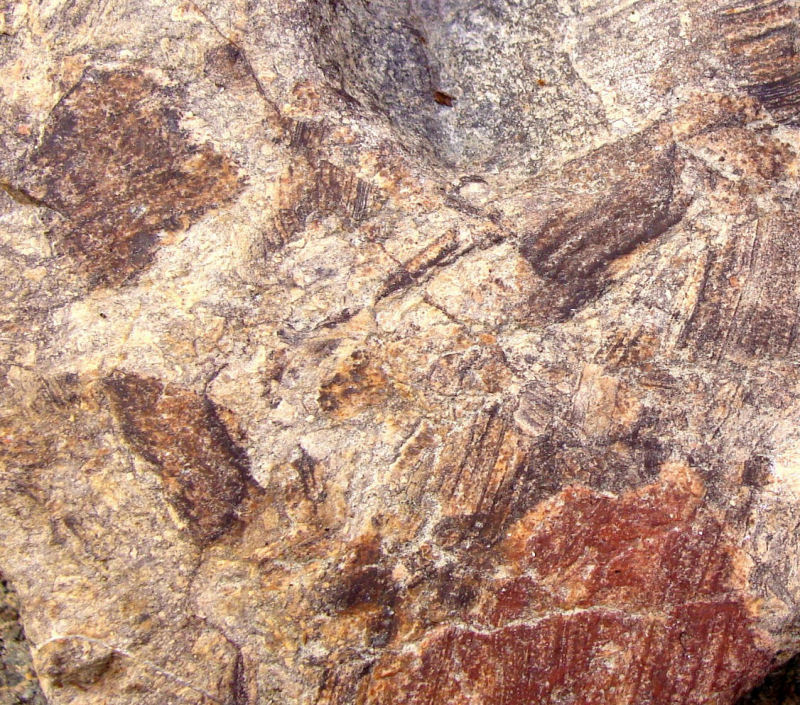 |
Former flow-banded rhyolite fragments in an agglomeratic unit. |
| |
Inland, on the NE side of Les Grands Vaux in Trinity, there is a purple tuffaceous rock which cannot be correlated with anything in the St. John's Rhyolite Formation and has been named the Trinity Ignimbrite
Spherulitic Rhyolites of the Bouley Rhyolite Formation.
Spherulitic rhyolites crop out on the northern and eastern coasts but differ markedly on each coast. On the north coast, the Bouley Rhyolite Formation crops out in Giffard Bay and consists of the Gifford Rhyolite overlain by the Giffard Andesite, Ignimbrite and Tuffs and finally by Les Platons Rhyolite. Throughout the sequence there are xenoliths of older rocks, sub-aerial, lacustrine and fluvial deposits (tuffs?) and flow banded, spherulitic rhyolites, the largest spherulites being in Les Platons Rhyolite in Giffard Bay and on Les Hurets, a line of N-S crags to the west of Bouley Bay. On the east coast, north of Anne Port Bay, the Formation consists of the Anne Port Rhyolite (overlying the Anne Port Ignimbrite) which is massive, flow banded, strongly columnar jointed at La Crête Point (our own 'Giant's Causeway', La Chaussée de la Crête, Nichols and Hill, 2004, p. 21), and spherulitic. |
| |
 |
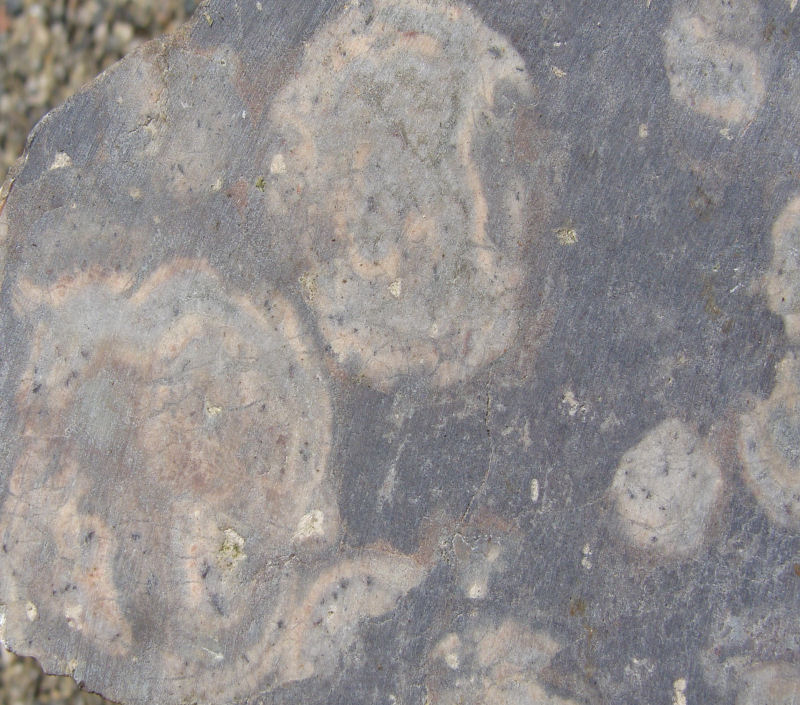 |
Spherulites (1 -2 cm) in hand specimen and cut specimen, Les Platons Rhyolite. |
| |
In Bouley Bay, there are three ignimbrite units, the Lower, Middle and Upper Bouley Ignimbrites, all of which are flow banded and strongly spherulitic (up to 10 cm) especially at Les Hurets, and have a variety of eutaxitic and fiamme textures giving them a flow banded appearance. |
| |
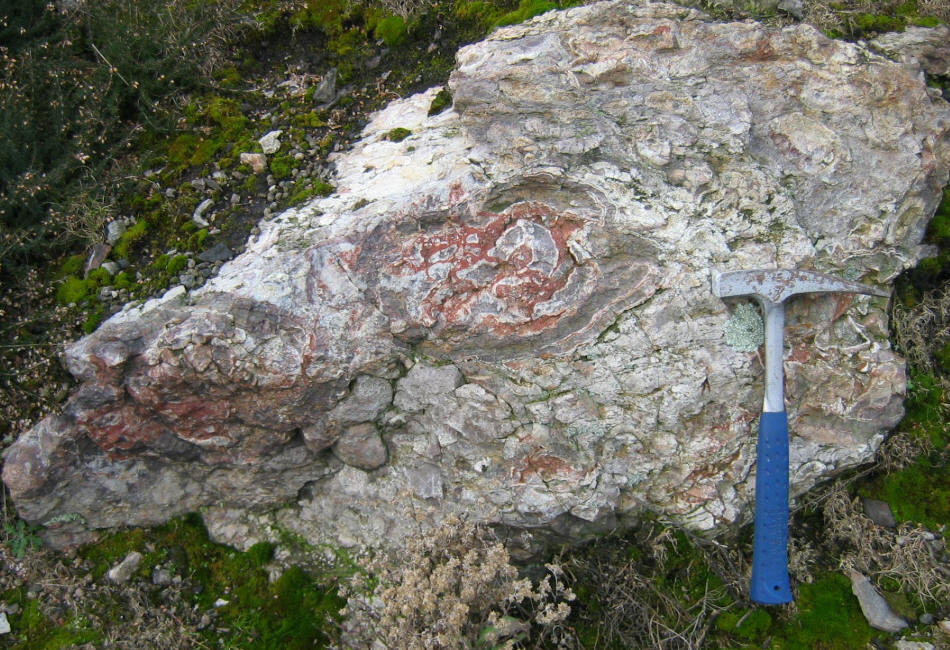 |
Rhyolite spherulites; with striking variation in size and composition, Lower Bouley Ignimbrite, Les Hurets crags (photo by Jo Sonnex). |
| |
I am indebted to Jo Sonnex (UCL) for showing me her inspiring photographs, and for her expert guidance and rapid access to the striking exposures of the large spherulites around the southern and eastern sides of Les Hurets.
Les Hurets form part of a ridge striking N-S above the western cliff coast of Bouley Bay. The ridge consists of two rocky outcrops separated by a slight col c.400m long; Les Hurets form the northern outcrop surmounted by the ruins of a former Guard House. They can be approached by the western cliff path from Bouley Bay. Around the 'alpine' turns there are small outcrops of flow-banded rhyolite, agglomerate and spherulitic rhyolite. The first crags, facing inland, are approached uphill through gorse and fern but reveal an excellent variety of spherulites and flow-banded rhyolite (below). Walking northwards through more gorse and fern across the broad col is the best approach to the seaward facing crags of Les Hurets where there are more fine exposures of spherulites. The slopes below are steep and search for further outcrops will be concentrated along the coastal area from Bouley Bay, in the winter when the fern has died down. |
| |
 |
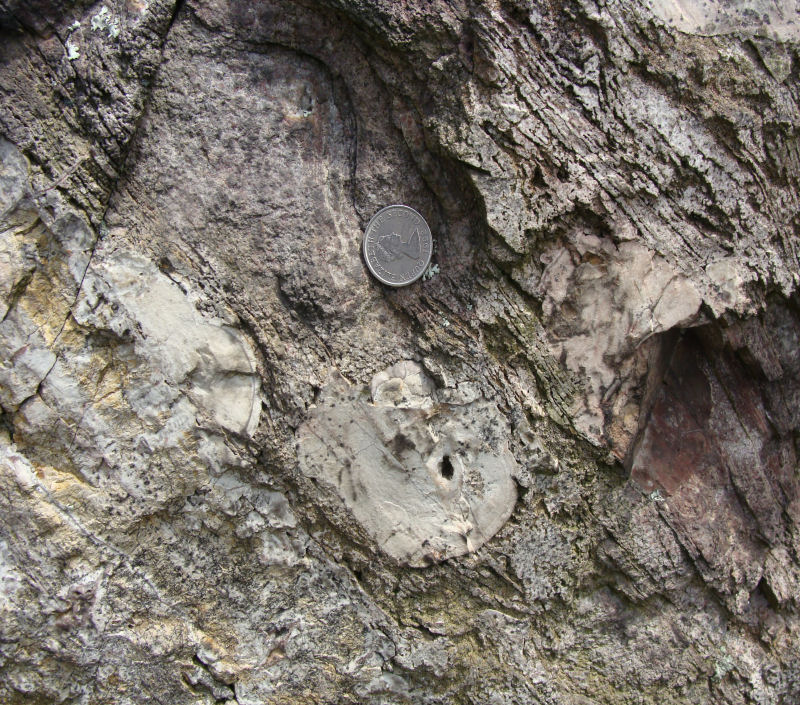 |
| |
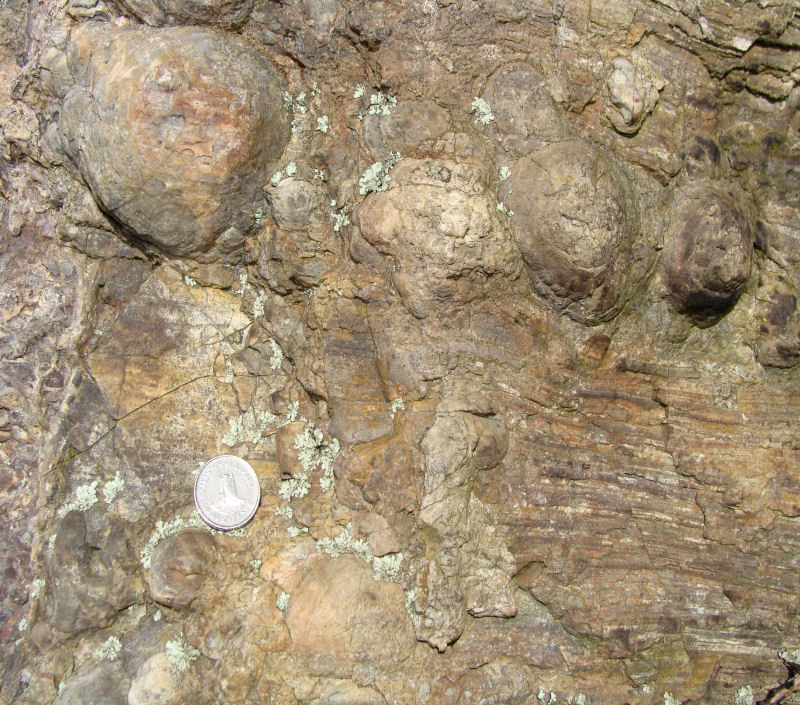 |
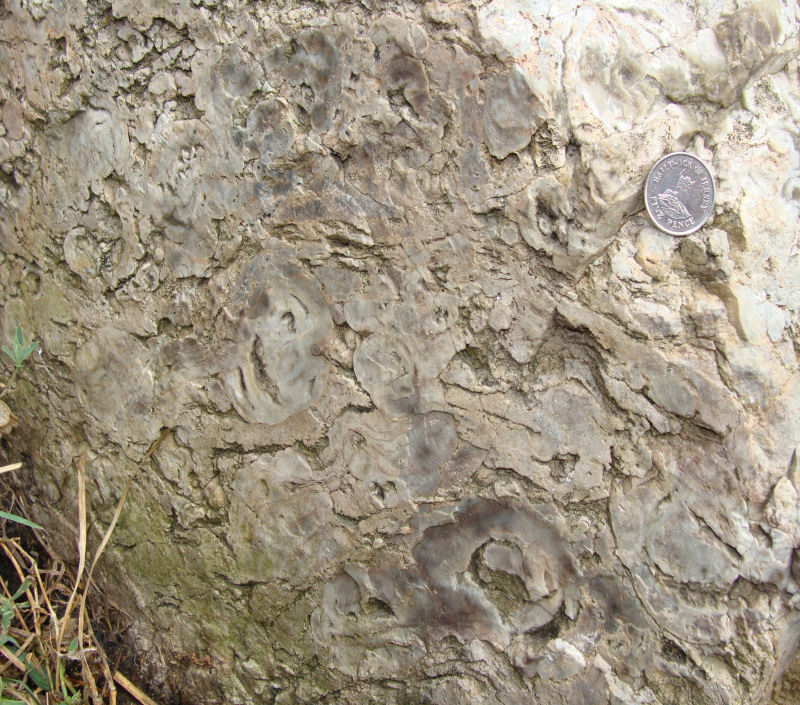 |
| |
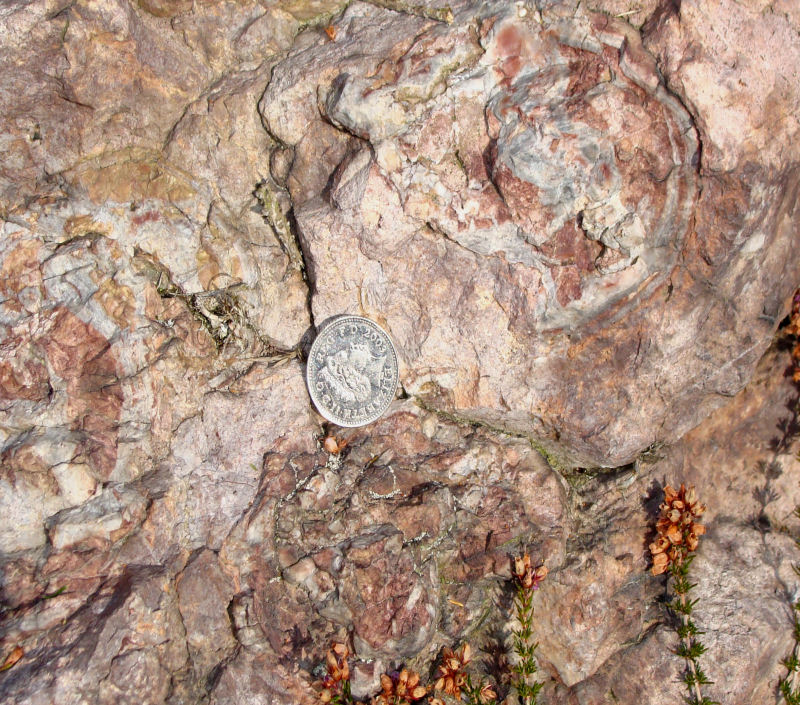 |
 |
| |
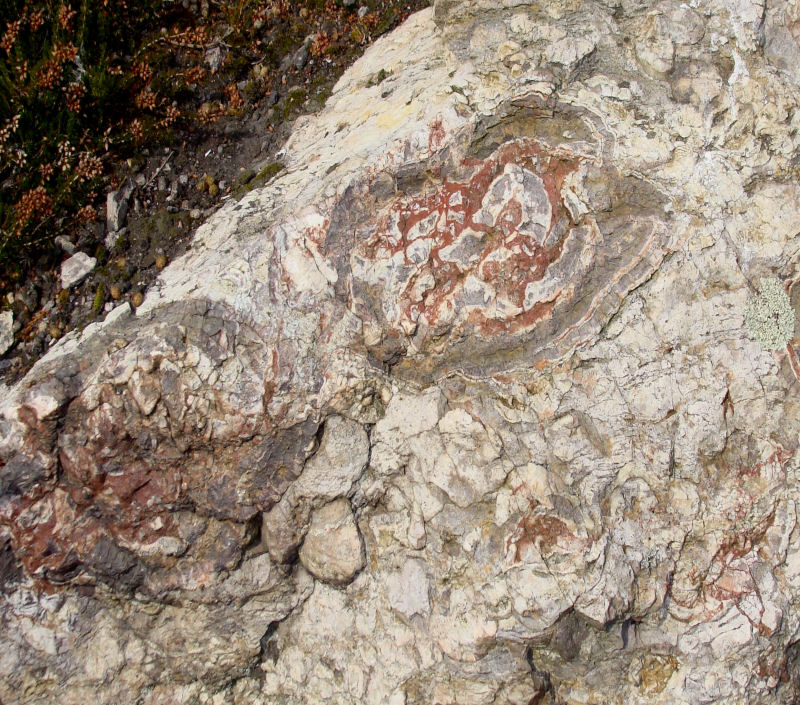 |
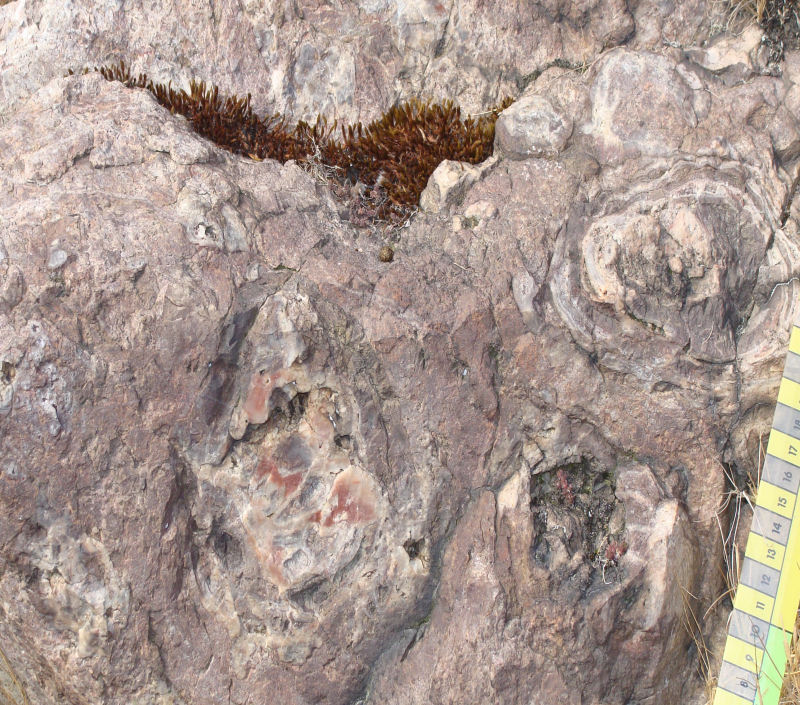 |
Spherultic rhyolites, west side of Bouley Bay, forming the crags up on Les Hurets. |
| |
The spherulites in the Bouley Bay area were described and interpreted by English, Jersey and French geologists and mineralogists such as Davies, Noury, de Lapparent and Parkinson from 1879 - 1898, and in fine detail by Arthur Mourant (1932, pp. 227 - 238) who lists the authors in his bibliography. He remarks on the presence of small, simple spherulites (op.cit. p. 228) but describes and illustrates spherulites from Les Hurets and from an offshore rock east of the south end of the St. Catherine's Bay sea wall. |
| |
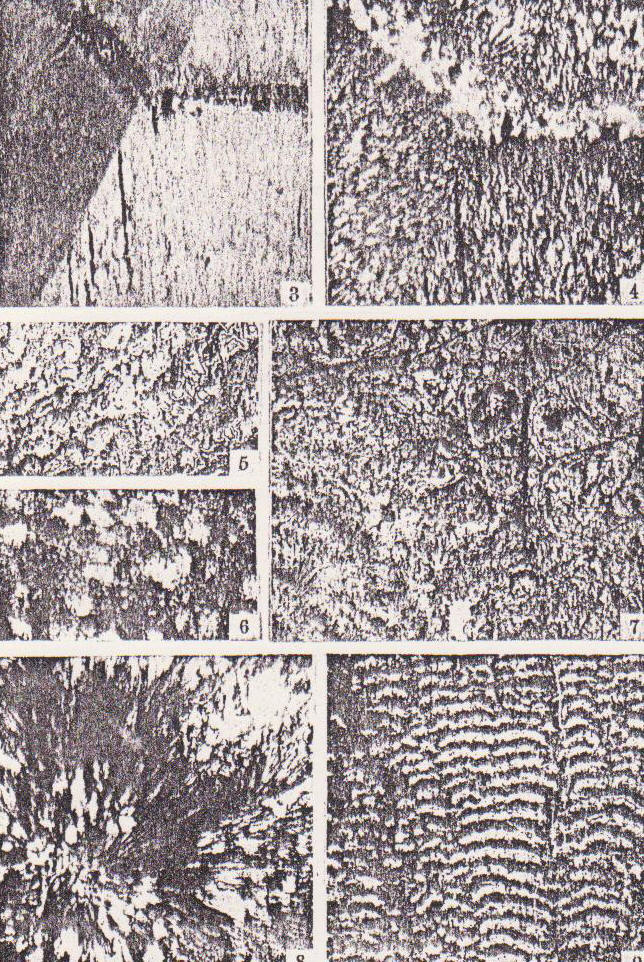 |
| |
Mourant concentrates on the large spherulites and remarks on the primary spherultic growth of "radiating and more or less branching felspar fibres" and a "patchy mosaic of quartz grains" enclosing the fibres poikilitically and which themselves are "elongated in the radial direction" but are not as "regularly arranged as the felspar" (op. cit. p.229). The rhythmic appearance is caused by an alternation of felspar zones and quartz, either symmetric or asymmetric and is "suggestive of rhythmic growth" (op. cit. p. 230) which is then more fully described (op. cit. pp. 232 - 237). The spherulites are not always discrete units and coalescent or compound ones exist, suggesting interference during growth.
On the east coast, north of Anne Port Bay, the Formation consists of the Anne Port Rhyolite (overlying the Anne Port Ignimbrite) which is massive and flow banded, and strongly columnar jointed at La Crête Point. (The polygonal columns are inclined to the south, presumably because the flow has a tectonic dip northwards. Stereographic projection studies might be able to determine the flow's original angle of rest.)
The upper part of the flow-banded, columnar unit at La Crête also contains intervals of small white spherulites, 1-3 mm in diameter. They vary from single to compound and in some cases appear to have internal and external crenulated margins. The white core, thought to be feldspar, surrounds a pink feldspar crystal in some cases, is minutely speckled in others, and appears pitted possibly due to weathering in yet others. |
| |
 |
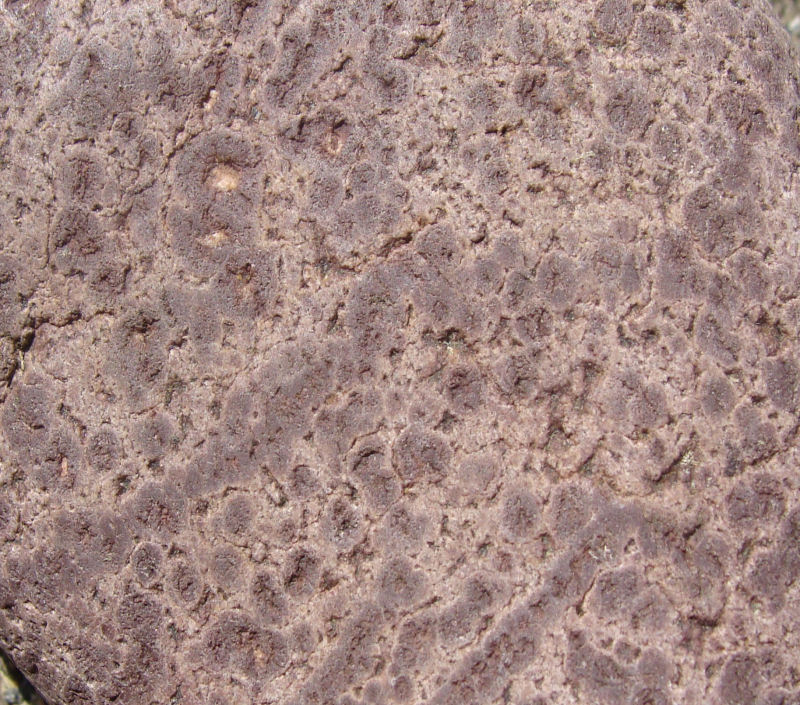 |
| |
Very narrow, sometimes anastomosing, maroon lines are present in some but the repeated, concentric banding and radiating structure are not evident. The white cores however, are surrounded by a very narrow banded rim. These bands are alternately grey and maroon, possibly of cryptocrystalline silica, with the maroon being more haematite-rich. The junction with the white core is irregular, giving the sometimes crenulated appearance, while the outer junctions show a coalescent structure, in some cases interrupting the spherical development of adjacent spherulites. |
| |
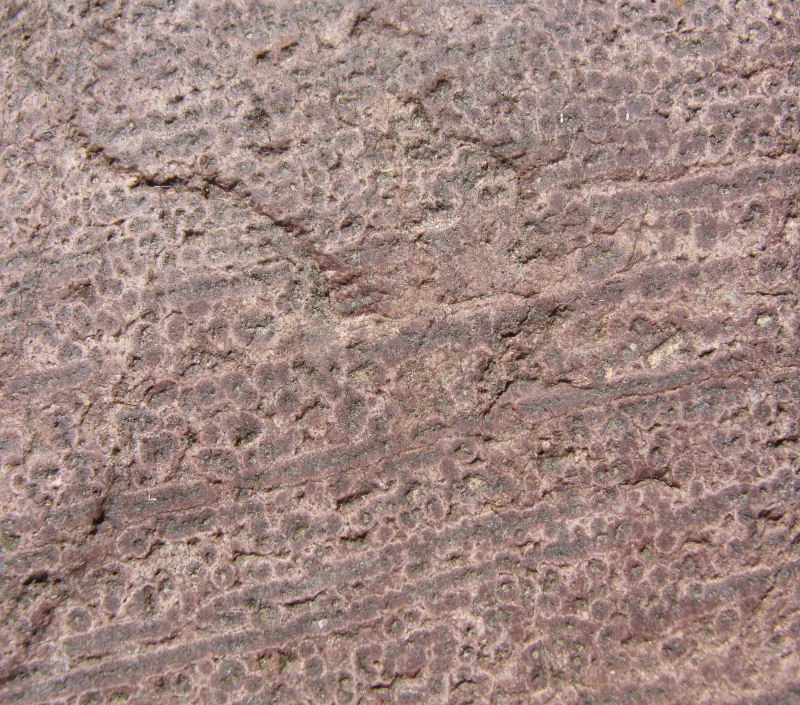 |
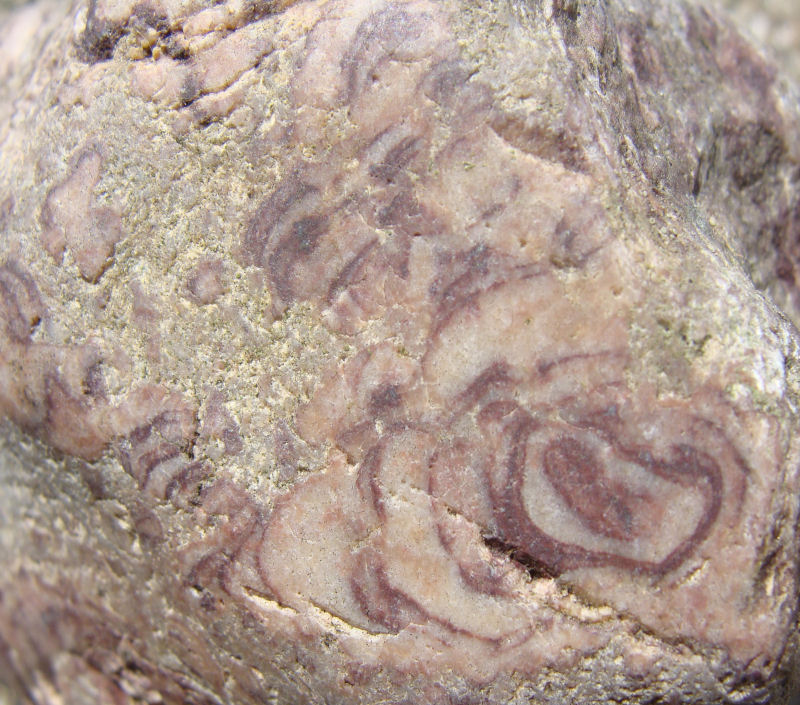 |
| |
Other examples of small spherulites have also been found as beach pebbles and show a wide variation in structure. They occur as discrete or compound maroon spherulites in patches and in layers between narrow maroon flow bands set in a lighter, pinker groundmass. Some exhibit a concentric structure around a core, while others form an apparently featureless, cryptocrystalline maroon mass. Of the coalescent ones, rosettes are one of the more unusual structures. |
| |
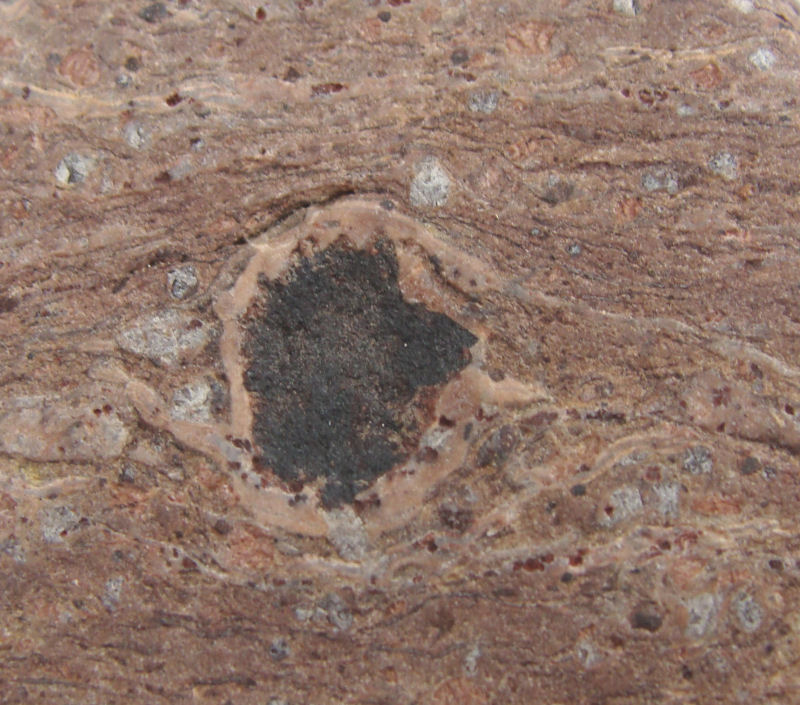 |
 |
Spherulitic clasts or stages of growth ? |
| |
 |
Small rosettes or clusters (bottom left) & broken bands of spherulites. |
| |
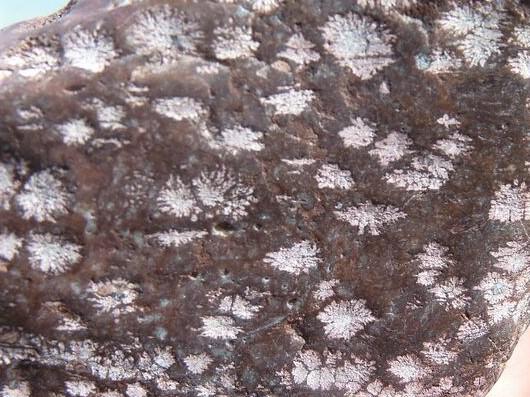 |
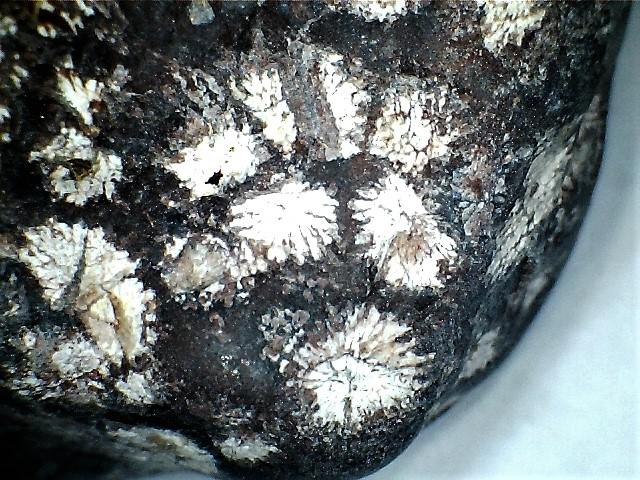 |
Spherulite variety, newly found and photomicrograph of same, St. Catherine, similar to the small white crenulated spherulites above. |
| |
 |
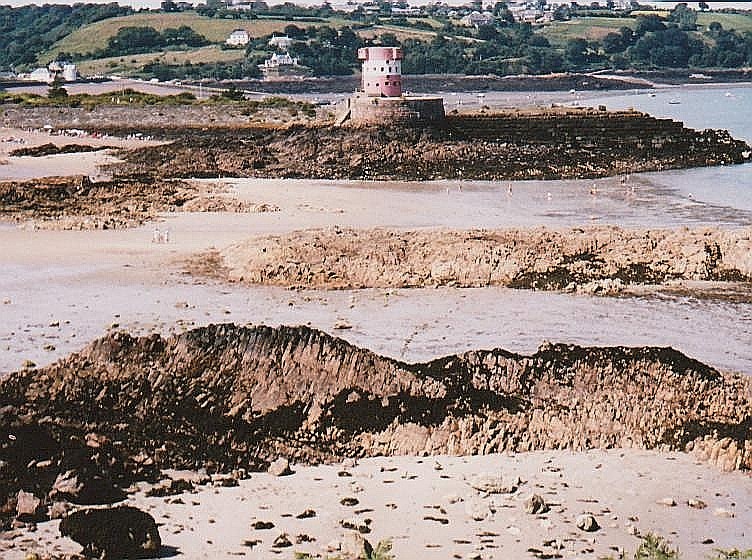 |
Columnar rhyolite, south-inclined, La Crête. |
Similar columnar outcrop, Le Havre de Fer. |
| |
A smaller outcrop of columnar rhyolite occurs immediately northwards in Le Havre de Fer beach between La Crête and Archirondel Round Tower, the two outcrops being preserved due to faulting (Robinson,1945-6, p.204). Northwards from Archirondel, there are more ignimbrites (the Archirondel, Dolmen and St. Catherine's Ignimbrites) with interbedded tuffs, all exhibiting the textures already described but also with pumice, quartz and albite fragments in a felsite matrix, often replace by haematite, which gives all the rhyolitic rocks their distinctive, but possibly uncharacteristic maroon colour. The uppermost unit is considered to be the St. Catherine's Ignimbrite and field relationships indicate a long period of erosion before its deposition.
Rhyolite Dykes. |
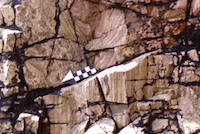 |
Flow banding in rhyolite dyke, St. Aubin - Belcroute. |
| |
These form part of the acid intrusions listed by Bishop & Bisson (1989, p.66.). They record three; one below Le Saut Jeffroi (Jeffrey's Leap, north and east)), another south of Le Mont Orgueil and the third on the east side of Noirmont headland by the short footbridge, half way between St.Aubin's Harbour and Belcroute Bay. The first two are described as porphyritic microgranite and strike c. NNE, whereas the last is a rhyolite. This last, c. 1m wide, intrudes the Jersey Shale Formation and is exposed in a low cliff section and in beach outcrops; it is noticeably light coloured, very light grey to pink and finely crystalline, and contains flow banded structures (Nichols & Hill, 2004, p. 32-33). It strikes E-W similar to the strike of the dolerite dykes but is the only example in this coastal area. The numerous others are dolerites with minor mica lamprophyres. Their origins are discussed more fully on the dykes page of the web-site. |
| |
|
References.
Bishop, A. C. and Bisson, G. 1989. Classical areas of British geology: Jersey: description of 1:25,000 Channel Islands Sheet 2. (London: HMSO for Brit. Geol. Survey.)
MacKenzie, W. S., Donaldson, C. H. & Guildford, C. 1982. Atlas of igneous rocks and their textures. Longman.
Mourant, A. E. 1932. The spherulitic rhyolites of Jersey. Mineral. Mag. Vol. 23. pp. 227 - 238.
Nichols, R. A. H. and Hill, A. E. 2004. Jersey Geology Trail. Private publication printed by The Charlesworth Group.
Robinson, A. J., 1945, 1946. Contribution to Geological Report for 1945. Bull. Soc. Jersiaise. Vol. XIV. Part VI. pp. 203-204. |
| |
| |
| |